Fabrication of Well-Aligned ZnO Nanorods Using a Composite Seed Layer of ZnO Nanoparticles and Chitosan Polymer
Abstract
:1. Introduction
2. Results and Discussion
2.1. The XRD Study of the ZnO Nanorods Fabricated Using Different Composite Seed Layers of ZnO Nanoparticles in a Chitosan Solution
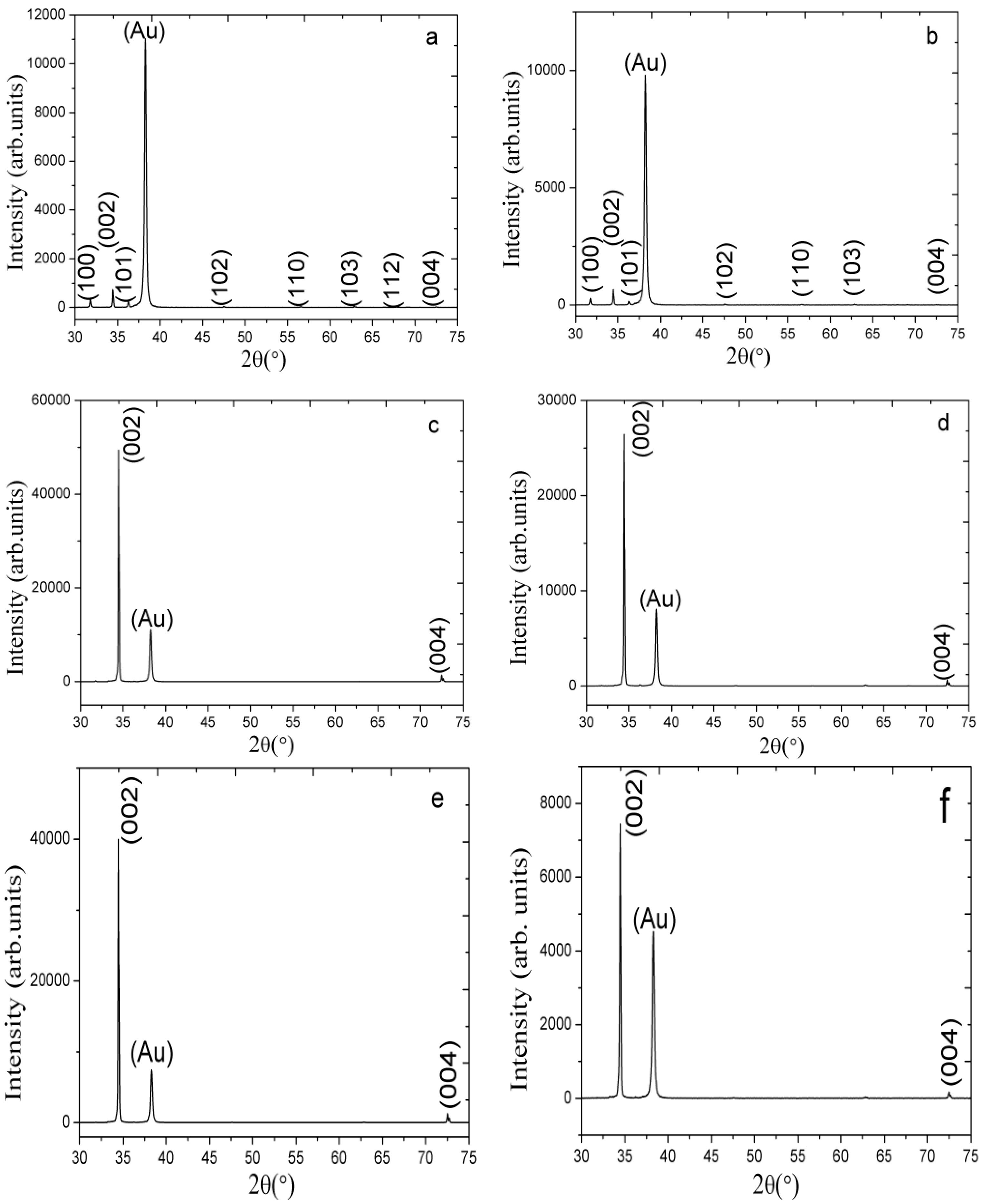
2.2. The Morphological Study of the ZnO Nanoparticles/Chitosan Composite Seed Layer-Coated ZnO Nanorods

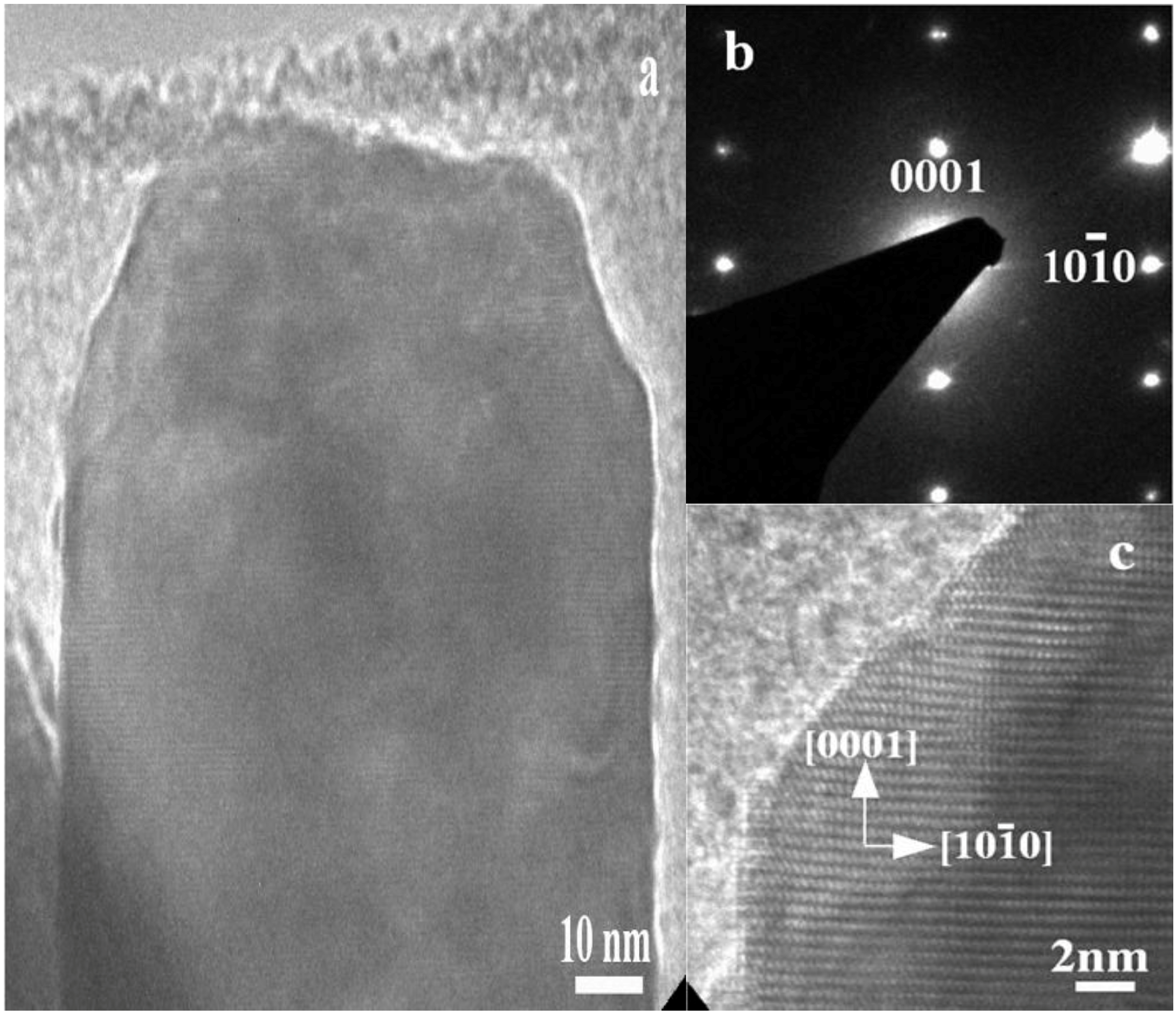
2.3. The Atomic Force Microscopic Study of the Composite Seed of ZnO Nanoparticles and Chitosan
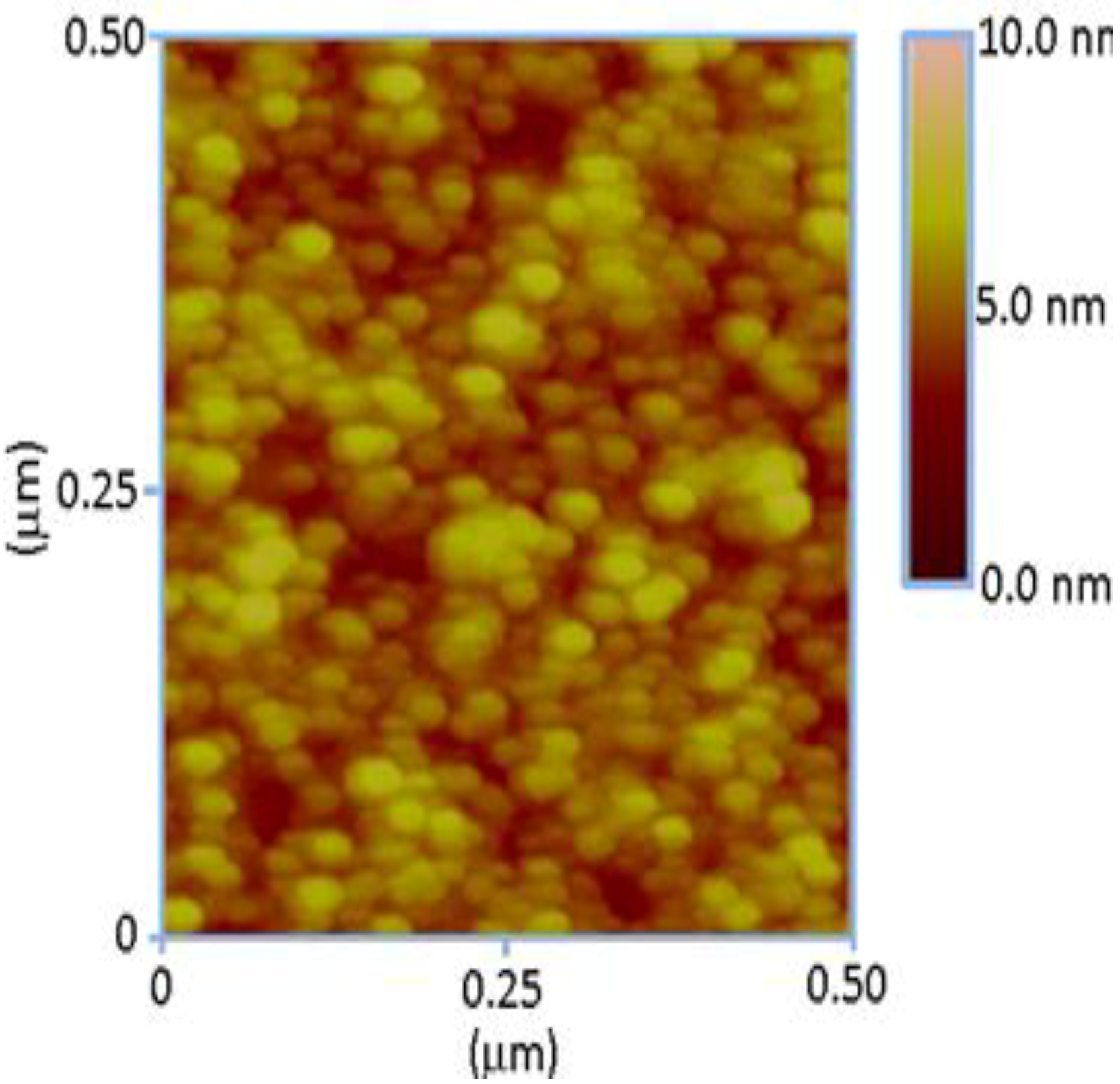
2.4. The (Fourier Transform Infrared Spectroscopy) FTIR Study of the Fabricated ZnO Nanorods
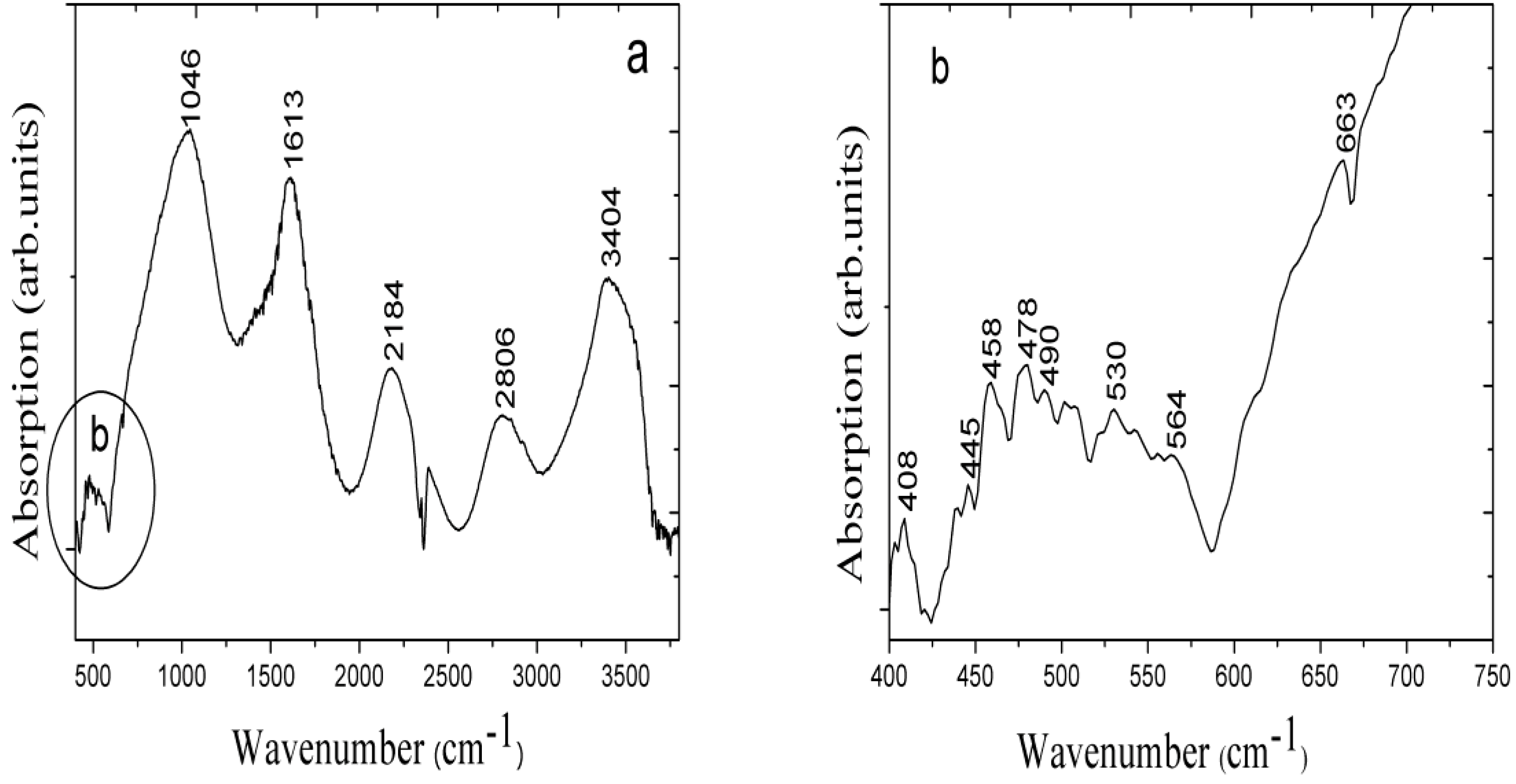
2.5. Raman Spectroscopic Study of the As-Synthesized ZnO Nanoparticles
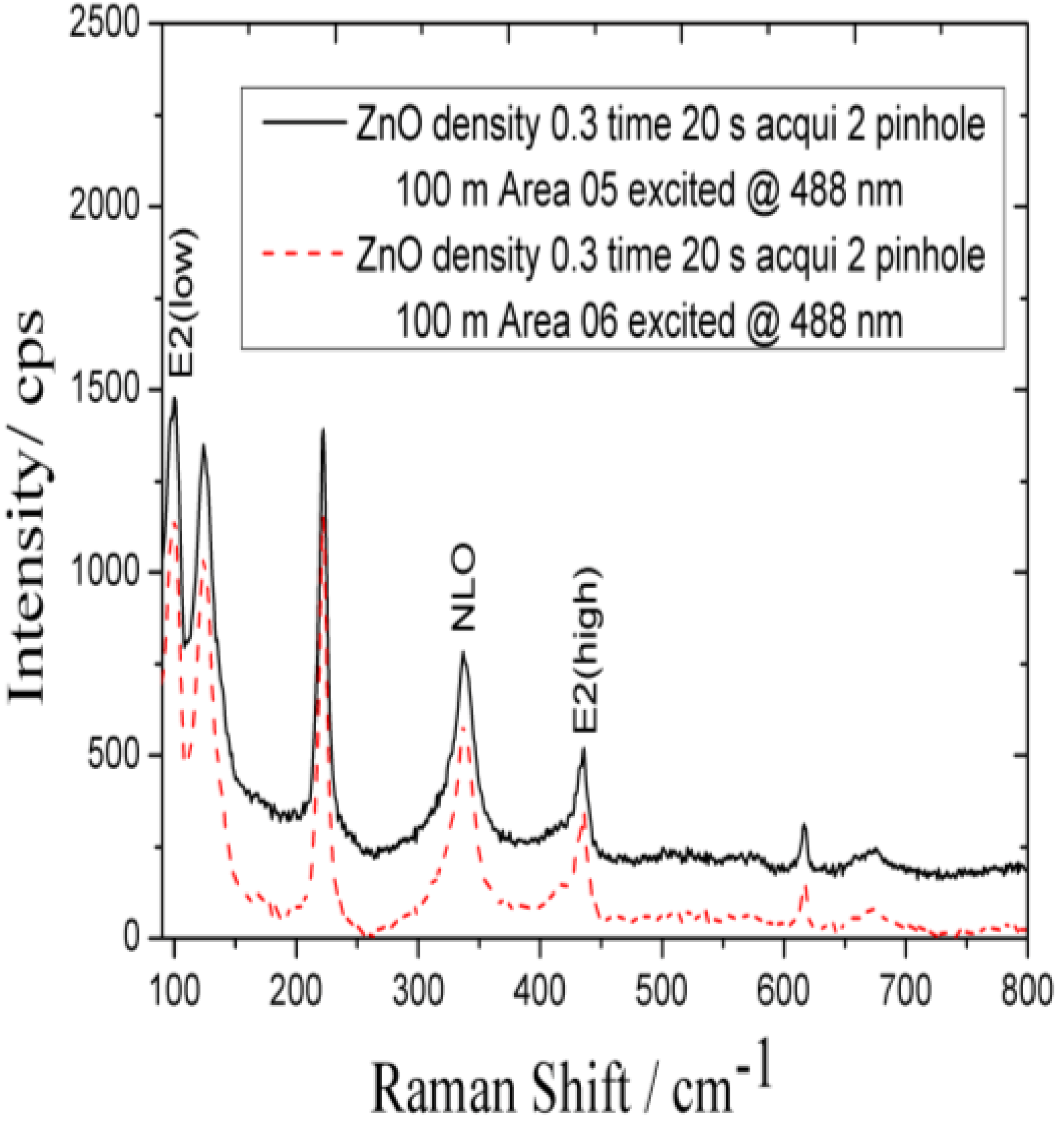
2.6. The Photoluminescence Study of the ZnO Nanoparticles/Chitosan Composite Seed Layer-Based ZnO Nanorods
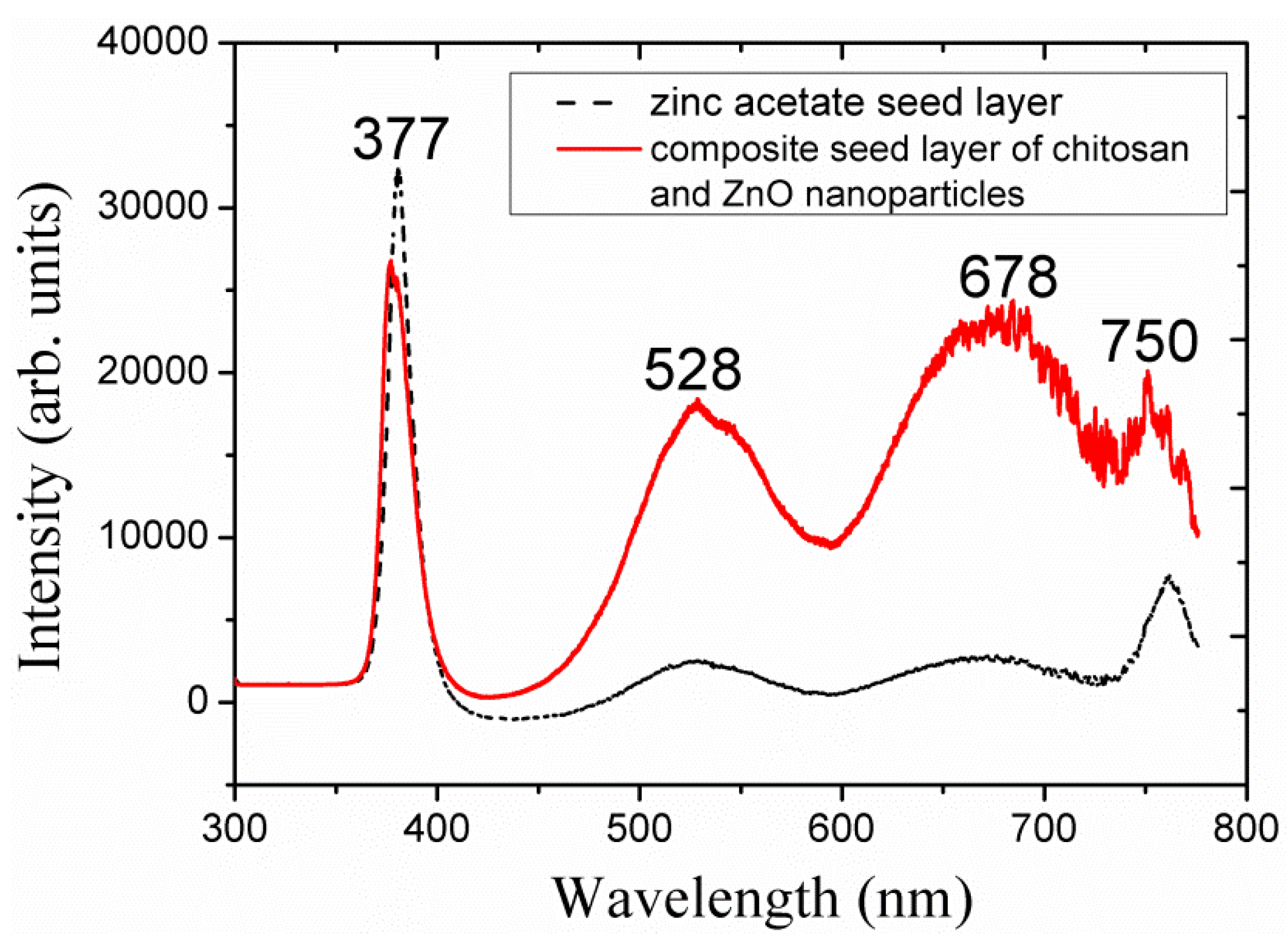
3. Materials and Experimental Section
3.1. Chemicals Used
3.2. Preparation of the ZnO Nanoparticles
3.3. Preparation of the Composite Seed Solution of ZnO Nanoparticles and Chitosan
3.4. The Growth of the ZnO Nanorods on a Gold-Coated Glass Substrate
3.5. Characterization of the As-Synthesized ZnO Nanostructures
4. Conclusions
Acknowledgments
Conflicts of Interest
References
- Polsongkram, D.; Channinok, P.; Purkird, S.; Chow, L.; Lupan, O.; Chai, G.; Khallaf, H.; Park, S.; Schulte, A. Effect of synthesis conditions on the growth of ZnO nanorods via hydrothermal method. Phys. B Phys. Condens. Matter 2008, 403, 3713–3717. [Google Scholar] [CrossRef]
- King, D.S.; Nix, R.M. Thermal stability and reducibility of ZnO and Cu/ZnO catalysts. J. Catal. 1996, 160, 76–83. [Google Scholar] [CrossRef]
- Zhong, J.; Kitai, A.H.; Mascher, P.; Puff, W.J. The influence of processing conditions on point defects and luminescence centers in ZnO. Electrochem. Soc. 1993, 140, 3644–3649. [Google Scholar] [CrossRef]
- Cao, H.; Xu, J.Y.; Zhang, D.Z.; Chang, S.H.; Ho, S.T.; Seelig, E.W.; Liu, X.; Chang, R.P.H. Spatial confinement of laser light in active random media. Phys. Rev. Lett. 2000, 84, 5584–5587. [Google Scholar] [CrossRef] [PubMed]
- Bagnall, D.M.; Chen, Y.F.; Zhu, Z.; Yao, T.; Koyama, S.; Shen, M.Y.; Goto, T. Optically pumped lasing of ZnO at room temperature. Appl. Phys. Lett. 1997, 70, 2230–2232. [Google Scholar] [CrossRef]
- Sales, B.C. Electron crystals and phonon glasses: A new path to improved thermoelectric materials. Mater. Res. Soc. Bull. 1998, 23, 15–21. [Google Scholar] [CrossRef]
- Trivikrama Rao, G.S.; Tarakarama Rao, D. Gas sensitivity of ZnO based thick film sensor to NH3 at room temperature. Sens. Actuators B 1999, 55, 166–169. [Google Scholar]
- Agarwal, G.; Speyr, R.F. Current change method of reducing gas sensing using ZnO varistors. J. Electrochem. Soc. 1998, 145, 2920–2925. [Google Scholar] [CrossRef]
- Huang, M.H.; Mao, S.; Feick, H.; Yan, H.; Wu, Y.; Kind, H.; Weber, E.; Russo, R.; Yang, P. Room-temperature ultraviolet nanowire nanolasers. Science 2001, 292, 1897–1899. [Google Scholar] [CrossRef] [PubMed]
- Wu, J.J.; Liu, S.C. Low-temperature growth of well-aligned ZnO nanorods by chemical vapor deposition. Adv. Mater. 2002, 14, 215–218. [Google Scholar] [CrossRef]
- Wu, J.J.; Liu, S.C. Catalyst-free growth and characterization of ZnO nanorods. J. Phys. Chem. B 2002, 106, 9546–9551. [Google Scholar] [CrossRef]
- Liu, R.; Vertegel, A.A.; Bohannan, E.W.; Sorenson, T.A.; Switzer, J.A. Epitaxial electrodeposition of ZnO nanopillars on single-crystal gold. Chem. Mater. 2001, 13, 508–512. [Google Scholar] [CrossRef]
- Govender, K.; Boyle, D.S.; Brien, P.O.; Brinks, D.; West, D.; Coleman, D. Room-temperature lasing observed from ZnO nanocolumns grown by aqueous solution deposition. Adv. Mater. 2002, 14, 1221–1224. [Google Scholar] [CrossRef]
- Vayssieres, L. Growth of arrayed nanorods and nanowires of ZnO from aqueous solutions. Adv. Mater. 2003, 15, 464–466. [Google Scholar] [CrossRef]
- Yamabi, S.; Imai, H. Growth conditions for wurtzite zinc oxide films in aqueous solutions. J. Mater. Chem. 2002, 12, 3773–3778. [Google Scholar] [CrossRef]
- Greene, L.E.; Law, M.; Goldberger, J.; Kim, F.; Johnson, J.C.; Zhang, Y.; Saykally, R.J.; Yang, P. Low-temperature wafer-scale production of ZnO nanowire arrays. Angew. Chem. Int. Ed. 2003, 42, 3031–3034. [Google Scholar] [CrossRef]
- Guoa, M.; Diao, P.; Cai, S. Hydrothermal growth of well-aligned ZnO nanorod arrays: Dependence of morphology and alignment ordering upon preparing conditions. J. Solid State Chem. 2005, 178, 1864–1873. [Google Scholar] [CrossRef]
- Vayssieres, L.; Keis, K.; Lindquist, S.E.; Hagfeldt, A. Purpose-built anisotropic metal oxide material: 3D highly oriented microrod array of ZnO. J. Phys. Chem. B 2001, 105, 3350–3352. [Google Scholar] [CrossRef]
- Vayssieres, L.; Keis, K.; Hagfeldt, A.; Lindquist, S.E. Three-dimensional array of highly oriented crystalline ZnO microtubes. Chem. Mater. 2001, 13, 4395–4398. [Google Scholar] [CrossRef]
- Agnihotri, S.A.; Mallikarjuna, N.N.; Aminabhavi, T.M. Recent advances on chitosan-based micro- and nanoparticles in drug delivery. J. Control. Release 2004, 100, 5–28. [Google Scholar] [CrossRef] [PubMed]
- Kim, S.K.; Rajapakse, N. Enzymatic production and biological activities of chitosan oligosaccharides (COS): A review. Carbohydr. Poly. 2005, 62, 357–368. [Google Scholar] [CrossRef]
- AbdElhady, M.M. Preparation and characterization of chitosan/zinc oxide nanoparticles for imparting antimicrobial and UV protection to cotton fabric. Int. J. Carbohydr. Chem. 2012, 2012, 840591:1–840591:6. [Google Scholar] [CrossRef]
- Hubbard, N.B.; Culpepper, M.L.; Howell, L.L. Actuators for micropositioners and nanopositioners. Appl. Mech. Rev. 2006, 59, 324–334. [Google Scholar] [CrossRef]
- Lee, H.J.; Yeo, S.Y.; Jeong, S.H. Antibacterial effect of nanosized silver colloidal solution on textile fabrics. J. Mater. Sci. 2003, 38, 2199–2204. [Google Scholar] [CrossRef]
- Wang, L.; Muhammed, M. Synthesis of zinc oxide nanoparticles with controlled morphology. J. Mater. Chem. 1999, 9, 2871–2878. [Google Scholar] [CrossRef]
- Xu, H.Y.; Wang, H.; Zhang, Y.C.; He, W.M.; Zhu, M.K.; Wang, B.; Yan, H. Hydrothermal synthesis of zinc oxide powders with controllable morphology. Ceram. Int. 2004, 30, 93–97. [Google Scholar] [CrossRef]
- Tani, T.; Mdler, L.; Pratsinis, S.E. Homogeneous ZnO nanoparticles by flame spray pyrolysis. J. Nanoparticle Res. 2002, 4, 337–343. [Google Scholar] [CrossRef]
- Wang, S.F.; Tseng, T.Y.; Wang, Y.R.; Wang, C.Y.; Lu, H.C. Effect of ZnO seed layers on the solution chemical growth of ZnO nanorod arrays. Ceram. Int. 2008, 35, 1255–1260. [Google Scholar] [CrossRef]
- Liou, S.C.; Hsiao, C.S.; Chen, S.Y. Growth behavior and microstructure evolution of ZnO nanorods grown on Si in aqueous solution. J. Cryst. Growth 2005, 274, 438–446. [Google Scholar] [CrossRef]
- Ahmad, U.; Riberiro, C.; Al-Hajry, A.; Yoshitake, M.; Hanh, Y.B. Growth of highly c-axis-oriented ZnO nanorods on ZnO/glass substrate: Growth mechanism, structural, and optical properties. J. Phys. Chem. C 2009, 113, 14715–14720. [Google Scholar] [CrossRef]
- Yuan, K.; Yin, X.; Li, J.; Wu, J.; Wang, Y.; Huang, F. Preparation and DSC application of the size-tuned ZnO nanoarrays. J. Alloy Comp. 2010, 489, 694–699. [Google Scholar] [CrossRef]
- Vayssieres, L. An aqueous solution approach to advanced metal oxide arrays on substrates. Appl. Phys. A 2007, 89, 1–8. [Google Scholar] [CrossRef]
- Kleinwechter, H.; Janzen, C.; Knipping, J.; Wiggers, H.; Roth, P. Formation and properties of ZnO nanoparticles from gas phase synthesis processes. J. Mater. Sci. 2002, 37, 4349–4360. [Google Scholar] [CrossRef]
- Vanheusden, K.; Warren, W.L.; Seager, C.H.; Tallant, D.R.; Voigt, J.A.; Gnade, B.E. Mechanisms behind green photoluminescence in ZnO phosphor powders. J. Appl. Phys. 1996, 79, 7983–7991. [Google Scholar] [CrossRef]
- Raju, K.; Ajeet, K.; Pratima, R.S.; Anees, A.A.; Manoj, K.P.; Malhotra, B.D. Zinc oxide nanoparticles-chitosan composite film for cholesterol biosensor. Analytica Chimica Acta 2008, 616, 207–213. [Google Scholar] [CrossRef] [PubMed]
© 2013 by the authors; licensee MDPI, Basel, Switzerland. This article is an open access article distributed under the terms and conditions of the Creative Commons Attribution license (http://creativecommons.org/licenses/by/3.0/).
Share and Cite
Khun, K.; Ibupoto, Z.H.; AlSalhi, M.S.; Atif, M.; Ansari, A.A.; Willander, M. Fabrication of Well-Aligned ZnO Nanorods Using a Composite Seed Layer of ZnO Nanoparticles and Chitosan Polymer. Materials 2013, 6, 4361-4374. https://doi.org/10.3390/ma6104361
Khun K, Ibupoto ZH, AlSalhi MS, Atif M, Ansari AA, Willander M. Fabrication of Well-Aligned ZnO Nanorods Using a Composite Seed Layer of ZnO Nanoparticles and Chitosan Polymer. Materials. 2013; 6(10):4361-4374. https://doi.org/10.3390/ma6104361
Chicago/Turabian StyleKhun, Kimleang, Zafar Hussain Ibupoto, Mohamad S. AlSalhi, Muhammad Atif, Anees A. Ansari, and Magnus Willander. 2013. "Fabrication of Well-Aligned ZnO Nanorods Using a Composite Seed Layer of ZnO Nanoparticles and Chitosan Polymer" Materials 6, no. 10: 4361-4374. https://doi.org/10.3390/ma6104361




